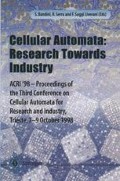Abstract
In this work the model of a single-layered Reaction-Diffusion Machine (RDM) [2], [4] is stressed in order verify some features of the proposed computational model for modeling and simulating coffee percolation where transportation and reaction-diffusion processes occur.
Access this chapter
Tax calculation will be finalised at checkout
Purchases are for personal use only
Preview
Unable to display preview. Download preview PDF.
References
Bandini S., Cattaneo G., Rigotti M., A Cellular Automaton Model for the Hydrodynamics of Percolating Systems, in S. Di Gregorio, G. Spezzano (eds.), “Automi Cellulari per la Ricerca e per l’Industria”, Atti Convegno Nazionale ACRI, Rende, 1994.
Bandini S., Simone C., Steps towards a Reaction-Diffusion Model fag-Representing Locality, Awareness and Recursiveness in Complex Organizations, Journal of the National Institute of Industrial Engineering, vol. Vol XVIII, n. 3&4, 1995.
Bandini S., Simone C., Reaction-Diffusion Computational Models, Proc. 3rd Systems Science European Congress, Rome, 1996.
Bandini S., Simone C., Integrating Forms of Interaction in a Distributed Coordination Model,Foundamenta Informaticae, 1998 (to appear).
Lenormand R., Zarcone C., Invasion Percolation in an Etched Network: Measurement of a Fractal Dimension, Physical Review Letters, vol. 54 n. 20, 1985.
Mandelbrot B., The Fractal Geometry of Nature, W. H. Freeman and Co., New York, 1983.
Nicoli M.C., Lerici C.R., Dalla Rosa M., Caratteristiche Chimiche dell’Estratto di Caffe: Nota I. Cinetica di Estrazione della Caffeina e delle Sostanze Solide, Industrie Alimentari, 1987, pp. 467–471.
Petracco M., Phisico-Chemical and Structural Characterisation of “Espresso” Coffee Brew, ASIC, 13 Colloque, Paipa, 1989.
Petracco M., Suggi Liverani F., Espresso Coffee Brewing Dynamics: Development of Mathematical and Computational Models, ASIC, 15 Colloque, Montpellier, 1993.
Rothman H., Cellular-Automaton fluids: a Model for Flow in Porous Media,Geophysics, vol.53 n.4, 1988.
Sahimi M., Applications of Percolation Theory, Taylor amp; Francis, London, 1994.
Spiro, M., Modelling the Aqueous Extraction of Soluble Substances from Ground Roast Coffee, Journal of Sciences of Food and Agricolture,n. 61, 1992.
Stauffer D., Aharony A., Introduction to Percolation Theory, 2nd ed., Taylor & Francis, London, 1992.
Wilkinson D., Willemsen J., Invasion Percolation: a New Form of Percolation Theory, J. Phys. A: Math. Gen. 16, 1983.
Wolfram S., Statistical Mechanics of Cellular Automata,Rev. of Modern Physics, vol. 55, n. 3, 1983.
Worsch T., Programming Environments for Cellular Automata, in S. Bandini, G. Mauri (eds.), “Cellular Automata for Research and Industry”, Springer Verlag, London, 1997.
Zanoni B., Pagliarini E., Peri C., Modelling the Aqueous Extraction of Soluble Substances from Ground Roasted Coffee, Journal of Sciences of Food and Agricolture, n. 58, 1992.
Author information
Authors and Affiliations
Editor information
Editors and Affiliations
Rights and permissions
Copyright information
© 1998 Springer-Verlag London Limited
About this paper
Cite this paper
Bandini, S., Illy, E., Simone, C., Liverani, F.S. (1998). A Computational Model Based on the Reaction-Diffusion Machine to Simulate Transportation Phenomena: the Case of Coffee Percolation. In: Bandini, S., Serra, R., Liverani, F.S. (eds) Cellular Automata: Research Towards Industry. Springer, London. https://doi.org/10.1007/978-1-4471-1281-5_15
Download citation
DOI: https://doi.org/10.1007/978-1-4471-1281-5_15
Publisher Name: Springer, London
Print ISBN: 978-1-85233-048-4
Online ISBN: 978-1-4471-1281-5
eBook Packages: Springer Book Archive

